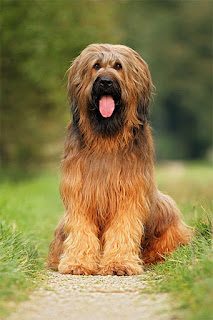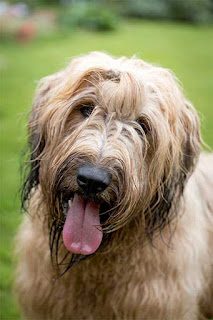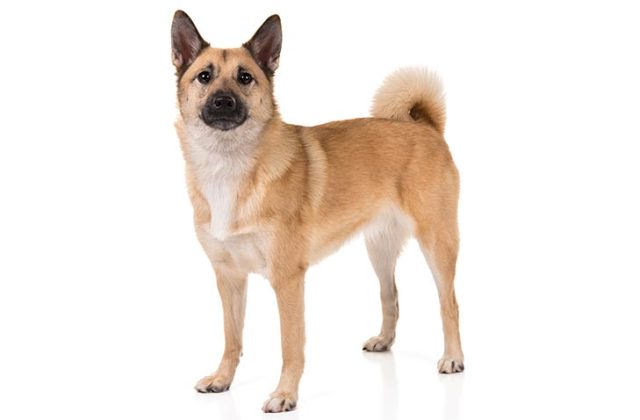Everything about your Briard
 Centuries old and beloved by the French since the Middle Ages, the Briard is busy, active dog that loves to protect his flock. And if he doesn’t have a flock to protect, he’ll be content watching over your family. Quite happy to move from the farm to a house, this breed is a wonderful companion for people who like to stay active. Also known as the Berger Briard, the Chien Berger de Brie and the Berger de Brie, the Briard is loyal to a fault and will love you with his whole heart, right from the start.
Centuries old and beloved by the French since the Middle Ages, the Briard is busy, active dog that loves to protect his flock. And if he doesn’t have a flock to protect, he’ll be content watching over your family. Quite happy to move from the farm to a house, this breed is a wonderful companion for people who like to stay active. Also known as the Berger Briard, the Chien Berger de Brie and the Berger de Brie, the Briard is loyal to a fault and will love you with his whole heart, right from the start.
Overview
Often called “a heart wrapped in fur,” the Briard makes a great family dog. He is devoted to his owner, happiest following you around the house while you do chores or watching you watch television on a rainy day.
With a strong instinct to herd, it’s not unusual for him to try to gather or keep the children or adults in his family within certain boundaries. He may nudge, push, or bark at his “flock.”
The Briard is an intelligent breed and a quick study when it comes to training, though he can be stubborn and want to do things his own way. Owners must be prepared to establish pack leadership from an early age or the dog is likely to take a shot at the role himself.
The Briard is an ideal companion for someone who wants a lovable, but not overly dependent, dog. A member of the Herding Group, he weighs in at around 75 pounds and lives comfortably in the country or city — as long as he’s with his family and gets sufficient exercise.
Highlights
- The Briard needs daily grooming. Although his coat is considered low- to non-shedding, it tangles and matts easily. If you do not have the time or patience for grooming, consider another breed.
- The Briard is naturally independent, which is a wonderful quality if your puppy has been trained properly. However, without training, that independent, confident puppy can turn into an unmanageable adult.
- The Briard must be socialized early to avoid aggression toward people or animals he doesn’t know. Briards were bred to be guard dogs and still take this role seriously.
- The Briard enjoys being with his owner. He does best when he is allowed to hang out with the people he loves.
- To get a healthy dog, never buy a puppy from an irresponsible breeder, puppy mill, or pet store. Look for a reputable breeder who tests her breeding dogs to make sure they’re free of genetic diseases that they might pass onto the puppies, and that they have sound temperaments.

- The Briard’s long coat can be any color except white. It is usually black, gray or tawny.
- In France, the breed is called the Berger (bair-zhay) de Brie (bree).
- The Briard’s tail is in the shape of a J, like a shepherd’s crook. It’s known as a crochet hook.
- Briards can be found participating in herding, agility and obedience trials, as well as flyball competitions.

Health
With such a large breed, you can expect hip dysplasia and bloat to be an issue with the Briard. As well, they may also suffer from cataracts, central progressive retinal atrophy, congenital stationary night blindness, hereditary retinal dystrophy of Briards, hypothyroidism and lymphoma.
Care
The Briard’s coat must be brushed regularly to prevent the hair from tangling. Herding is its favorite activity, but it can also be taken for long walks or jogs in order to meet its exercise requirements. And though it is adaptable to outdoor living, it is most often considered an indoor dog. Just make sure you take it to large fields and let it play frequently.
Living Conditions
The Briard will do okay in an apartment if it is sufficiently exercised. They are moderately active indoors and will do best with at least an average-sized yard. This dog is totally not suited for life in a kennel. They are happiest in the home as part of the family, but they do love to be outdoors.
Trainability
Briards are highly trainable dogs and thrive on mastering new tasks. Training should always be done with a confident but gentle hand, as this breed is highly sensitive and boasts a long memory. A Briard isn’t easy to forgive someone who treats him harshly. Establishing leadership should be done as early as possible, because Briards are dominant and will move quickly to take over the role of “pack leader” in the home, unless otherwise put in his place.
This breed is fearless boasts excellent stamina. They can work all day alongside a farmer without losing steam and because of their versatility, trainability and endurance, Troops in WWI used Briards for a variety of tasks including, sentries, messengers and medic dogs.
Exercise
This is no dog for the lazy. This dog needs plenty of activity to keep him occupied – both physical and mental. Farms make an ideal environment for this breed, where he can herd sheep and protect against predators. If you don’t live on a farm, a large, fenced-in yard is necessary. Children will help tire him out, but playtime should always be supervised as he might herd the kids.
Because they need a large area in which to move around, apartments and condos are not good living quarters for the Briard. They just won’t get the exercise they need in that small amount of space.
Grooming
The Briard’s coat is long and very high-maintenance. While no stripping is required, two to three hours per week of brushing is required in order to keep their thick coats from matting. When brushed properly, dirt and debris is easily removed from the coat. They shed lightly year round, but will blow their entire coat twice per year. The coat of a Briard can grow to about five inches in length, which is the acceptable standard, and in fact, clipping can lead to disqualification in the show ring. Retired Briards, or dogs who will not be shown, can have their coats trimmed in order to pear down the weekly maintenance schedule.
As the Briard sheds, if the undercoat is not properly removed from the body, it will form mats.
Briards need to be bathed about once every six weeks. Over-bathing this breed can lead to natural oils in the hair and skin being stripped away, causing skin irritation and even infection. The Briard’s face and rear end may need to be washed more often, as their beards can hang into their food and water dishes, and their long hair can trap debris when the dog eliminates.
In addition to brushing and bathing, Briards should have their ears cleaned on a weekly basis with a veterinarian-approved cleanser to keep harmful bacteria at bay. Weekly tooth brushing will keep teeth and gums healthy, and prevent bad breath.
Children And Other Pets
A loving and playful companion, the Briard makes an excellent family dog. He is protective of the children in his family, and has been known to “defend” them when parents discipline.
As with every breed, you should always teach children how to approach and touch dogs, and always supervise any interactions between dogs and young children to prevent any biting or ear or tail pulling on the part of either party.
Teach your child never to approach any dog while he’s eating or sleeping or to try to take the dog’s food away. No dog, no matter how friendly, should ever be left unsupervised with a child.
If the Briard is raised with other dogs and pets, and learns they are members of his pack, he gets along fairly well. However, his prey drive is strong, so training is necessary for him to learn not to chase the family cat or quarrel with your Beagle. Supervision is a good idea, as animals outside his immediate family are likely to trigger his instinct to give chase. Keep him on a leash when you are in public.
Is the Briard the Right Breed for you?
High Maintenance: Grooming should be performed often to keep the dog’s coat in good shape. No trimming or stripping needed.
Moderate Shedding: Routine brushing will help. Be prepared to vacuum often!
Moderately Easy Training: The Briard is average when it comes to training. Results will come gradually.
Very Active: It will need daily exercise to maintain its shape. Committed and active owners will enjoy performing fitness activities with this breed.
Good for New Owners: This breed is well suited for those who have little experience with dog ownership.
Good with Kids: This is a suitable breed for kids and is known to be playful, energetic, and affectionate around them.
 |
| Sam and Ralph clock |
Briards have made a variety of big and small-screen appearances, most notably in the series “Married With Children” and the soap opera “All My Children,” as well as the movies “Top Dog” and “Dennis the Menace.”
Briards in popular culture
- Dennis the Menace – “Ruff“
- Kiss Kiss Bang Bang – “Stevie“
- Bachelor Father – “Jasper”
- Get Smart – Agent K-13 “Fang”
- Dharma & Greg – “Stinky”
- Addams Family – “Them”
- Top Dog – “Reno“
- Dennis the Menace (1993) – “Rosie“
- The Karate Dog 2004
- Tell No One 2006
- Sam Sheepdog of Looney Tunes fame






